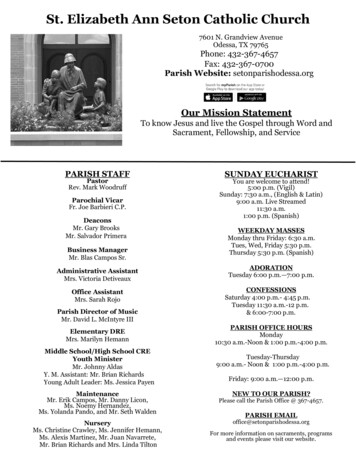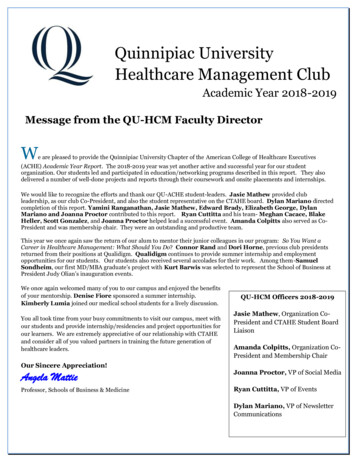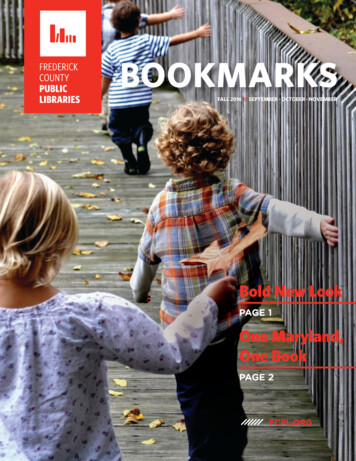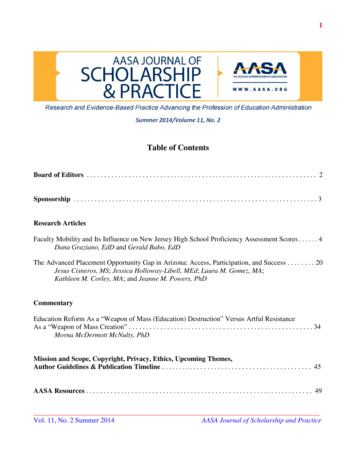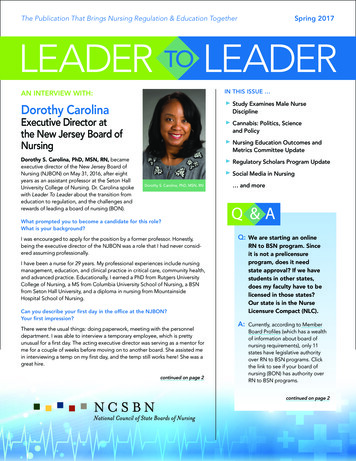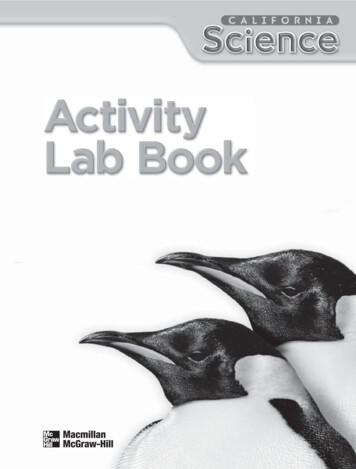
Transcription
FORWARDthe alumni magazine of Seton Hill University
FORWARD Fall & Winter 2012MESSAGE from the PRESIDENT2DR. WIERSZEWSKI’S INNOVATIVETEACHING TECHNIQUES6A Moment in Time9Tanzania to Pennsylvania10TURNING PHAGES ON A NEW SCIENCE COURSE16Catharine Murray Ryan ReceivesHighest Honor20Experiencing the world and Teaching25THE “CROSSE” YOU BEAR30The Right to Grow34CAMPUS NEWS38Seton Hill Honors Two at Graduation42FAIRWAY FIXER46Distinguished Alumni48Alumni events519.Cover Artist - Carol BrodeCarol Brode is an assistant professor of art and director of the Harlan Gallery at Seton Hill. Sheteaches studio art courses, including painting, printmaking and mixed media. She is a member ofthe College Art Association, the Associated Artists of Pittsburgh (past board member and exhibitionschair) and Group A; Carol is listed in the Marquis Who’s Who of American Women.Her work has been exhibited at the Carnegie Museum of Art, The Mattress Factory, the State Museumof Pennsylvania and the Pittsburgh Center for the Arts, as well as in many other galleries and venues.Her artwork is in the collections of many regional corporations, including Westinghouse, DuquesneLight, Dravo Corporation and others, as well as in many private collections.Regularly, Carol conducts European study tours for students and travels frequently to view currentexhibitions. In the past she has taken students to Italy, England, France, Germany, the Czech Republicand Greece. Carol received both her Bachelor of Arts and Master of Arts degrees from IndianaUniversity of Pennsylvania and completed additional graduate study at New York University, as wellas post-baccalaureate studies in art education at the University of Pittsburgh.
the alumni magazine of Seton Hill UniversityFEATURED ARTICLESInstitutional AdvancementChristine M. Mueseler6.Vice President for Institutional Advancement724-838-4232mueseler@setonhill.eduMolly Robb ShimkoAssociate Vice President for ll.edu16.Carol J. BillmanDirector of Grants and Government Support724-838-4204billman@setonhill.eduLisa A. CarinoDirector of the Annual Fund and Major Gifts724-838-2409carino@setonhill.eduKary Coleman HazenDirector of Media Relationsand Forward Project Manager724-830-1069coleman@setonhill.edu20.Emily HeinickaAssociate Director of ew MillerDirector of Development Information Systems724-830-1137amiller@setonhill.eduJustin Norris10.06. Dr. Wierszewski’s innovativeDirector of Development724-830-1899norris@setonhill.edu34.16. Turning Phages on a Newteaching techniquesScience CourseThe iPad Comics for Life app allows anyoneto design, write and format their own comicstrip or even an entire graphic novel.Students are getting their hands dirty in aninnovative new science course this fall atSeton Hill University.10. From Tanzania to PennsylvaniaHard work and service defineBovey Masiole’s journey.20. The Elizabeth Ann Seton MedalCatharine Murray Ryan receives highestSeton Hill University honor.34. The RIght to growSeton Hill University and Saint VincentCollege communities participated in a jointservice trip to Managua, Nicaragua.Christy PergarAssociate Director of the Annual Fund724-830-4636pergar@setonhill.eduMary Ross CoxDirector of Alumni Relations724-830-1027cox@setonhill.eduKristofer SmithDirector of Corporate and Community w Perspective, www.new-perspective.comANNUAL REPORT OF DONORS DESIGN:George Fetkovich, Apollo Design Group, Inc.Writers:Ashley Brewer, Cara DeCarlo, Lauren Jones,Heidi Ruby Miller, Jennifer Reeger, Kara Rhodesphotography:Mark Fallone, Jim Judkis, Eric Schmadel,Sean Stipp, Jack Wolf, SHU staff and studentsalumni news supplement design:Dragon’s Teeth DesignSETON HILL UNIVERSITYMISSIONSeton Hill is a Catholic Universityrooted in Judeo-Christian values.In the tradition of Elizabeth AnnSeton, we educate students to thinkand act critically, creatively, andethically as productive membersof society committed to transformingthe world.printer:Laurel Valley GraphicsForward is published by Seton Hill University,Greensburg, PA 15601-1599, (724-830-1005),http://www.setonhill.edu, for the alumni andfriends of the University. Postage paid atGreensburg, PA.Seton Hill University, as a matter of tradition andprinciple, does not discriminate on the basis of race,creed, gender, age, disability, or national and ethnicorigin in the administration of its educationalpolicies, scholarship and loan programs, andathletic and other university-administered programs.Seton Hill University adheres to the non-discriminationlegislation of both the federal government and theCommonwealth of Pennsylvania, including, but notnecessarily limited to, the Civil Rights Act of 1964,Title VI, Title IX, 1972 Handicap Provision, and theAmericans with Disabilities Act.
Message from the presidentMessage from the PresidentDear Alumni and Friends,"During my 25-yeartenure as presidentand in earlier yearsas both a studentand a member ofthe faculty, I havealways knownthere is somethingvery special aboutSeton Hill."In my message to you last year, I reminded youthat at Seton Hill University, we remain awarethat there will be no return to a simpler timewhen market forces will play a less dominaterole in American education. After all, theseforces encourage us to evaluate all we do andhow well we do it. Responding to the marketdoes not mean compromise. It does mean thatwe must be ever conscious of maintainingSeton Hill’s special identity as a Catholic liberal(some would say “liberating”) arts universitywhile keeping costs manageable for our studentsand their families.When students ask me what is most importantto their Seton Hill University experience, besidethe pursuit of academic excellence, I ask themto keep three things in mind:First, in an increasingly competitivejob market, the workplace of tomorrow willbe looking for graduates who have done theirlearning using advanced technology – especiallymobile technology.Second, I tell them that the hallmarkof successful college graduateswill be their ability to consistently makegood decisions in a constantly changing world.I advise them to study deeply, take advantageof opportunities to study abroad (or anywherethey will be exposed to a new culture or newway of doing things), and seek out the professors and programs and friends who will challenge them to learn new things and supportthem while doing so.Most important, I remind them notto neglect their spiritual growth.Our global community needs strong youngmen and women who can think and act critically, creatively and ethically – in every profession,and in all aspects of life. I know our studentsfind it heartening to learn of all you do toadvance the communities in which you liveand work.2FORWARD Fall & Winter 2012During my 25-year tenure as president and inearlier years as both a student and a memberof the faculty, I have always known there issomething very special about Seton Hill.Throughout its changes, and the changes in themarketplace, the essential Seton Hillness of thisplace shines through.At the University, we remain committedto our mission and to enhancing theacademic distinctiveness that hascontributed to the rich characterof a Seton Hill education.On behalf of the students, faculty and community who benefit in many ways from yourgifts, I thank you for your belief in Seton HillUniversity. A new horizon beckons and we willcontinue to respond, with enthusiasm, withcare and with joy.Sincerely,JoAnne BoylePresident
Message from the presidentThe Importance of Souvenirsat thePresident JoAnne Boyle addressed the freshman classvations:Fall Honors Convocation. Among some of her obsera magnificent journey. My adviceWell, here you are at the beginning ofNot the kind you put in a drawerto you: Collect some souvenirs.lurking around in the memory box ofor on a shelf, but the kind that will always beBy its end, you should have an impressiveyour mind. Today starts your unique journey.way. Here are some ways to get startedassortment of souvenirs accumulated along theon your collection:architecture. Study it. Learn allFall in love with a piece of art ored it. Make a promise to yourself thatabout it and the artist and people who creatsomeday you will go to see it face to face.to Chartres Cathedral just outsideTake that journey—perhaps it will ber Florence to see Michelangelo’s statueParis—or to Rome to see the Sistine Chapel—ohistory professor Maureen Vissat onof David perhaps you will do this with artplan for it now. Go with professor Johnone of her spectacular trips to Italy. Start tosty, see the Ming Tombs or ShandongSpurlock to China, learn about the Ming DynaGo to France to visit the Louvre, theProvince to walk where Confucius walked.ste Rodin—to Israel to contemplatePompidou and the art and architecture of Auguthe lessons of the Holocaust at Yad Vashem.www.setonhill.edu3
Message from the presidentGet obsessed with a concept,a theorem, a puzzle, a formula—andbecome the world’s foremost thinkeron the subject. Or, if not the world’s,at least Greensburg’s.Learn a poem—by heart. If you want short, go to EmilyDickinson and discover the virtue of brevity—or Robert Frost “The way a crow shook down on me the dust of snow froma hemlock tree ” or carry Hamlet’s soliloquy with you, orhis famous musing, “What a piece of work is man! How noblein reason. In action how like an angel; in apprehension howlike a god.”Discover a philosopher or a theologian whointrigues you. Pick one of the old Greek philosophers,Plato or Aristotle, or a theologian, John Henry Newman orEdith Stein. These philosophers and theologians had plentyto say about why we exist. Claim them, read their work, talkback to them, make their ideas your own. Frame a world viewand tell your friends. “I see things this way because I am anAristotelian” or “I am influenced by John Henry Newman.”Go to see the library of his work in Pittsburgh and then onto England.Find a piece of music from the past and put it inyour head. Trace its links between then and now. Whoapplauded it? Who critiqued it? Marvel over how Puccini’sgreat opera, “La Boheme,” became the Broadway hit, “Rent,”or “Madame Butterfly” was transformed into “Miss Saigon.”Listen to the profound silences of John Cage! Ask yourself,“what’s that all about?”I know a prominent person who finds himself with extra timeon his hands. He plans to use that time to read up on theRussian Revolution. He’s already an expert on the Civil War,Abraham Lincoln and Tolstoy. Don’t wait for extra time to studyin depth.I’ve been asking people what they know by heart. Does it surpriseyou that the most common answer is Lincoln’s GettysburgAddress ? You won’t regret adding that to your memory bank.One of my sons said to me, “I first heard it when I took mychildren to Gettysburg. It brought tears to my eyes and Idecided then and there I would have those lines on call, with mewhenever I wanted them. I memorized them that very day andI’ve never regretted it.”Your four years here will be over before you know it. “What willI have in my souvenir bag?” you might want to ask. Start thinkingabout what you want to find among your souvenirs. Make acheck list, and put it on your Mac or bulletin board. Do not leaveSeton Hill without your souvenirs.Someday, “ages and ages hence” that “will have made allthe difference.”Study history. Get fascinated with great figures from thepast—Cleopatra, Napoleon,Chairman Mao—discover their circleof friends, and enemies, and how one thing led to another. Myown operational definition of history has often been how onething leads to another.4FORWARD Fall & Winter 2012
Message from the presidentHazard Yet ForwardApps, Attitude and AdventureJust a few months ago the editor of Pittsburgh Quarterly invitedme and regional higher education leaders to answer the followingquestion,“What is the biggest issue or issues facingyour institution and/or higher educationtoday, and what are possible solutions?”At Seton Hill we are obsessed with several issues that can beturned into the following questions: How do we harnessthe energy, power and potential of technologyto improve learning? Given a changing and challengingnew student population, how can we be more creative, innovative and effective when we teach? What are the opportunities fordeepening learning and understanding offered by the mobiledevices students carry with them everywhere? Are we ready forthe changes that loom ahead on the landscape of higher education?Can we be an exciting part of that change?Seton Hill’s mobile learning program was conceivedand is now implemented as a way to capture and keep the attentionof students as they pursue studies in all disciplines. Turn the pageand you will read about how students in Dr. Emily Wierszewski’sbasic composition class are introduced to the principles of rhetoric—ethos, pathos and logos—through a graphic novel app.We continue to see energizing change inthe way our faculty think about their courses,the way learning is evaluated, and the waystudents are getting and staying involved.Out of these questions have come some ofSeton Hill's solutions. We've established a centralplace for innovative thinking about teaching, the Center forTechnology Innovation and Excellence in Teaching, where weconsider our most vexing questions including how will weknow that what we are doing with technology has improvedstudent learning. Then, because every faculty member, administrator, staff member, student and trustee in the institution has an iPad, a MacBook, or both, through the Center weoffer in-depth training, coaching, electronic hand-holding andcounseling as we discover and explore and experiment withthe capacity and power of go-with-you-anywhere learningtools. Results so far are impressive: "flipped" classrooms, virtual learning labs, new ways to reach students with disabilities,teach languages, compose an essay, visualize a math concept.www.setonhill.edu5
The "crosse" you bearSeton Hill'sSuper Woman Or is that justDr. WierSZewski?Dr. Emily Wierszewski,assistant professor ofEnglish and composition atSeton Hill University and super hero?Well, not exactly, but shedoes have her head in thecomics—the ones madeby her writing students.6FORWARD Fall & Winter 2012
Dr. Wierszewski’s innovativeteaching techniquescall upon the iPad Comics for Life app, which allows anyone todesign, write and format their own comic strip or even an entiregraphic novel. That’s exactly what two sections of Dr. Wierszewski’sBasic Composition classes did in the fall of 2011.Her first brush with the medium came while studying ScottMcCloud’s theory of comics during graduate school at EasternMichigan, where she used the printed works as a student in theclassroom before the big influx of technology. But it was technology and the iPad which brought Dr. Wierszewski back to thewonderful world of comics and graphic novels.After attending a conference for the International Society forTechnology and Education (ISTE), Dr. Wierszewski was inspiredto incorporate more technology into the classroom, especiallyplaying up Seton Hill’s iPad and MacBook program. Once shefinished Seton Hill’s own technology instruction program,Elite, she began looking for apps she could utilize in class.“I was thinking how to integrate the iPad and Macbook inmy basic composition course,” says Dr. Wierszewski. That’swhen she ran across the Comics for Life app, and the ideasstarted to flow.In fact, the students and Dr. Wierszewski all created their ownavatars, cartoon representations of themselves and others, byselecting from a group of pre-designed facial features, body types,and clothing. Not only was the exercise fun, it also had themall “thinking about the ways we represent ourselves visually andhow that can effect what people perceive of us. And how thatworks in a similar sort of way when we represent ourselves in text.”www.setonhill.edu7
Dr. Wierszewski’s innovative teaching techniques“We don’t often writein isolation anymore.We combine writingwith images, gestures,speech, and movement.” Dr. Wierszewskismiles at this lastthought, as ifpunctuating hersentiment. “I’m moreof a visual thinkerand found many ofmy students are, too.This app makes iteasier because nodrawing or advancedartistic abilityare necessary.”Comics take that representation to the nextlevel because they are “a great example of howwords and images are combined together incontemporary texts and offer students a great insightof study and production to examine rhetoricalprinciples.”Dr. Wierszewski sites example texts like “BlackHole” by Charles Burns, “Maus” by Art Spieglemanand this year’s summer reading for incoming freshman at Seton Hill, the graphic novel “Persepolis”by Marjane Satrapi.Each introduce students to the principles ofrhetoric—ethos, pathos and logos—throughwriting and images. Examining these rhetoricalprinciples on a theoretical level was a maincourse goal in Dr. Wierszewski’s Basic Compclasses. “And I wanted to show students how tointegrate differing opinions on issues. I chose tohave students actually create and read comicswith the Comics for Life app for iPad.”Dr. Wierszewski knew from experience that anynew technology introduced into the classroomhas to be user-friendly, so she told her studentsto experiment with the app, be creative, do something with it just for them. She made it clear fromthe beginning, though, that students wouldn’tbe penalized for handwriting and drawing theirassignments on paper. Most had a great deal offun with the app, however.All comics created by the students werenon-fiction.Their first project was a simple narrative so boththeir comics and essays needed to communicatewhy the students were here at Seton Hill. “Tojumpstart the project, we discussed how emotionis conveyed both visually and through text.” Thiswas an easy way for Dr. Wierszewski to illustratethe rhetorical principle pathos—winning overthe reader by appealing to their emotions.The class’ second project, this one fact-based,began with each student interviewing someoneabout their job. The comic especially came inhandy as a medium to show the exchange, presenting it in a logical manner. “Students sawfirst-hand how the organization of informationwithin a comic or essay can determine what people think about your content.”8FORWARD Fall & Winter 2012By the third project, students were pros at usingthe app, so Dr. Wierszewski challenged them tomake an instructional comic. The assignment?“Think about one piece of advice to help the nextgroup of incoming Seton Hill freshman that youwish someone had told you.” Students enjoyedthis exercise in ethos, building credibility and trustwith your audience through personal experience.At the end of the course, some students confidedto Dr. Wierszewski how much the Comics for Lifeapp made a difference in their writing. “Comicshelped them think about a new way to organizetheir thoughts and showed them how to prioritizeand discover what were the most importantideas that they had. And that this was sort of atake away that they could use in the future inwriting courses. While this wasn’t my originalintention, I was thrilled that I had reachedstudents who had different learning styles andthat they had found a tool that they could usebeyond just my classroom.”Not only did the students benefit by seeing howthe concepts of ethos, logos and pathos workedthrough a visual medium, but there was anotherbonus. “A lot of students appreciated using theiPad on a regular basis and discovering thisprogram that they could use for future purposes tomake the iPad worthwhile.” Dr. Wierszewski saysthe Comics for Life app isn’t just for storytelling ina writing classroom. She sees many purposes for itin other areas of study because it provides basics,such as organizing ideas, creating outlines, andcollecting notes and important images.Dr. Wierszewski sees a big future for the app andher courses. “I’ll include textual and auditory lessons,as well, even using it as an alternative way forstudents to express themselves. It could be forsomething small. I would love to team up withDr. Albert Wendland and his graphic novels class.Perhaps do something with the Writing PopularFiction MFA program. And, if I have time, itwould be great to make my own instructionalcomics.”Maybe Dr.Wierszewski really is Super Woman.-Heidi Ruby Miller, a freelance writer from Uniontown, Pa.
A Moment in Time:Preserving Choices We MakeIn Our LivesAssistant Professor of Art Carol Brode’sartwork as a metaphor for memoriesSome people travel for school or work. Some people travelto see the sights. Some people travel to get inspired. AssistantProfessor of art Carol Brode does all three. Over the years,Carol has traveled with, and without, Seton Hill Universitystudents to countries such as Greece, Italy, France, Germanyand Israel, to name a few. Drawn to the history of thesedestinations, Carol fell in love with the sights and sounds ofthese countries, and those trips provided inspiration for herrecent solo show at the Westmoreland Museum of American Art,entitled “One Time One Place.”Carol traveled to Israel to study the Holocaust at Yad Vashem in2009, and earlier in 2007 took 15 Seton Hill students to Greeceand Italy on a tour of ancient cities and settlements such asSantorini, or Thera, an ancient Greek settlement and the site ofa volcanic explosion 3600 years ago. The focus of the trip wasthe art and architecture of the ancient cultures. Taking pictures asinspiration on all of her travels, Carol is particularly drawnto passageways and doorways. For her, the contrast betweenlight and dark and the contrast between two spaces embody“a transition between time” and represent the “choices wemake in our lives.”In addition to her travels, Carol’s artwork is also influenced bythe poetry of T.S. Elliot. Mainly using mixed media encaustic,which is the process of layering hot wax over a collage of materials, she is able to create images that are metaphors for memory.By layering materials, the pieces invoke a translucent feelingand one has to look a bit closer to understand the intention.Carol’s objective is to challenge the viewer to “look deeper,”as one might “not see the whole picture right away.” By usingsnippets of T.S. Elliot’s poetry and text within her work, theviewer is provided with insights regarding Carol’s inspiration,passion and emotions for constructing the piece.Carol teaches a variety of these art techniques in her courses atSeton Hill, including mixed media painting, printmaking andan introduction to encaustic. Encouraging students to experiment with techniques and personal expression, Carol’s intentionis to expand her students’ knowledge base by explaining whycertain materials and techniques are used and not just how theyare used. When instructing her students in their own projects,she advises them to take viewer feelings into account anddetermine “the point” of their work, something every artistmust learn to define.For Carol, traveling provides endless inspiration for her artwork.By taking pictures on her journeys, her photographs capturemoments that represent a specific time and place in her life. Thepurpose of her work is to inspire the viewer to reflect on theirpersonal choices and to take a deeper look at their own momentsin time.-Lauren Jones is a freelance writer from Export, Pa.www.setonhill.edu9
Highest Seton Hill University HonorTanzaniatoPennsylvaniaBovey Masiole’s formal education beganby learning how to write with his fingerin the dirt outside his rural schoolin Tanzania. Twenty years later, he’sabout to earn a college degree fromSeton Hill, where an iPad andlaptop are his educational tools.10
Highest Seton Hill University Honor“When I came here, I didn’tneed much,” Bovey said.“I just needed an opportunityto make a future.”To get from Tanzania to Greensburg took years of hard work andsacrifice. And to succeed here hastaken Bovey’s unique look at life.“When I came here, I didn’t need much,”Bovey said. “I just needed an opportunityto make a future.”And make a future for himself andhis family he has.Bovey is set to graduate in May with threedegrees—in entrepreneurial studies, marketing and human resources management. He aims to work as hard as he canand learn all that he can during his time atSeton Hill. He has gotten deeply involvednot only in academics but also extracurricular activities, internships and jobs.He spent his first 14 years in a rural areaof Tanzania, where school was moreabout playing soccer with his friends thangetting an education. But at 14, with hisparents divorced, he moved to live withan uncle in Dar es Salaam, a major city inTanzania. There, the focus was on education.Bovey discovered that educationwould be the key to his future. Heneeded to pass a stringent nationalexam in order to get the governmentto pay for private high school. Fail it,and he would have no future.www.setonhill.edu11
Highest Seton Hill University HonorSo he put all of his efforts into his studies so he wouldn’t endup on the street. And after six years at private high schools,he decided to take the SAT and pursue his college educationin America for his best chance at success.Seton Hill was among the schools on his list. He begancorresponding by email with then-admissions counselor,Morgan Drenning, who considers Bovey a friend and brother.“Bovey is an excellent studentand extremely hard worker, butit’s his dedication to friends andfamily that truly sets him apart,”Morgan said.Seton Hill officials were impressed with Bovey enough tooffer him not only admission, but a financial aid packagethat made it possible for the young man – who had toscrounge up 40 cents for 30 minutes online at an internet café –to attend.When he arrived at Seton Hill in the fall of 2009 he had onething on his mind – success. “I took one option – you haveto make it,” he said. He devoted himself to his studies andto experiencing as many activities as he could.In his second semester, Bovey was named a Student Ambassador. Seton Hill alumna Anna Bevington Drenning servedas a Student Ambassador with Bovey, and he has spent holidaybreaks with her and her family.“Bovey has not only made a huge difference in my life, hehas made a difference in the lives of everyone in my family,”she said. “Hehas become part of ourfamily and will be forever.”A Dean’s List student, Bovey works as a resident assistantand he started a study group for students on his floor. Healways keeps himself busy. As a member of Seton Hill’sStudents in Free Enterprise, he was among the studentswho won the international group’s regional competition inBaltimore and traveled to the national competition inMissouri earlier this year.Over the summer, he interned with Seton Hill’s Office ofInstitutional Advancement, and he has one this fall withPrudential in Pittsburgh.12“It’s the motivation for you to goto work everyday,” he said. “Thereare so many people who are lookingfor you to not fail.”Bovey has also gotten involved in charitable work. He’svolunteered for the American Red Cross locally. But he doesinternational charity work as well. He sells bracelets, madeby individuals in Tanzania, with the proceeds going to helpAfrican children.In fact, his business plan for the bracelet charity won theWukich Center for Entrepreneurial Opportunities ElevatorPitch competition at Seton Hill earlier this year. He received 1,000 to invest into the charity. He is now working withSeton Hill’s Entrepreneur in Residence Michael Pochan ona social entrepreneurship business model.“We live in a collective society where it’s not only about youbut it’s about the people who surround you so you have tobe good with your neighbors,” he said.Bovey is still debating his future. He’s thinking about enrollingin Seton Hill’s MBA program, but he also thinks about going home and getting a job. “Every single day, I am gratefulfor the opportunities I have had,” said Bovey.-Jennifer Reeger is a freelance writer from Greensburg, Pa.
Highest Seton Hill University Honor“Every single day, I amgrateful for the opportunitiesI have had,” said Bovey.www.setonhill.edu13
2012 CommencementWukich Center for Entrepreneurial OpportunitiesEntrepreneur in Residence: Michael PochanMichael Pochan, who describeshimself as a “relentless, creativeproblem solver and entrepreneurthat will tackle any issue if peoplewant help,” serves as Entrepreneurin-Residence for the Wukich Centerfor Entrepreneurial Opportunities(CEO).Michael co-founded, led as CEO, grew and sold LeaseTek Inc.,a global business application software company with offices inPittsburgh, London, Stockholm and Sydney. LeaseTek served thelargest credit companies in the world - Ford Credit Europe, BMWFinancial, Dresdner Bank, VW Finans, AT&T Capital, HyundaiFinance, NCR Credit Worldwide and Toyota Motor CreditEurope. It was recognized as a global leader in asset-based leasingand finance. His company earned a spot in the Inc 500 for fastestgrowing privately-held companies in America.14Michael is a chemical engineer with an MBA from Carnegie Mellon.His favorite roles are marketing strategist and software engineer,combining technology and leadership concepts to achieve ontime product completion, competitive advantage and cash flowgrowth. He has been involved in several industries: coal andsynthetic fuels, nuclear power, asset based leasing and finance,online learning and wireless sensor networks. Michael is a frequent contributor to industry journals and editorial columns,has published many articles and was twice an invited speaker atthe World Leasing Conference.Michael was an adjunct faculty member at Carnegie Mellon’sTepper School of Business where he taught MBA courses andexecutive education. He was also a senior lecturer of business atCarnegie Mellon’s School of Computer Science.Today, Michael remains an executive advisor for Sensor Management LLC, a startup company tha
the iPad comics for life app allows anyone strip or even an entire graphic novel. From Tanzania To Pennsylvania Hard work and service define bovey masiole's journey. The righT To grow Seton Hill University and Saint vincent college communities participated in a joint service trip to managua, nicaragua. 06. 6. 16. 20. 10. 34.
